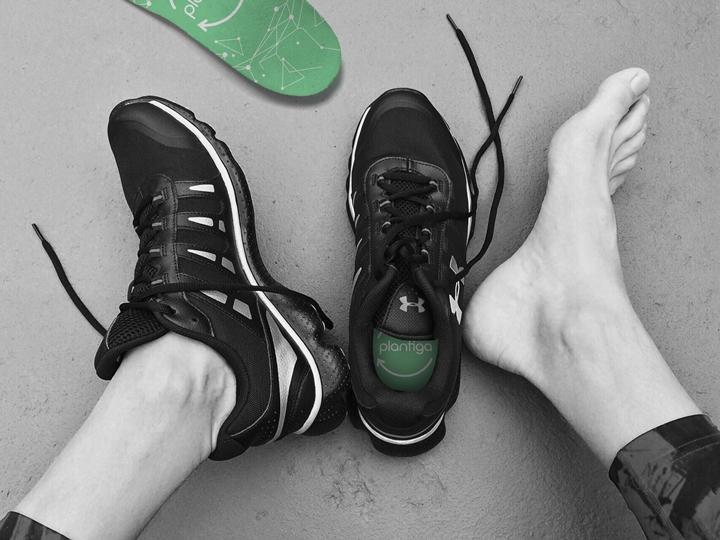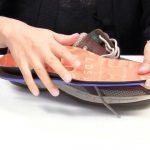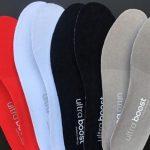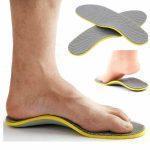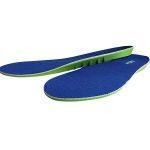Most people experiencing mild pain or discomfort in the area of the feet seek to get rid of it by ‘upgrading’ their shoes with orthotic insoles. Now, most people who are not too familiar with how this technology works assume that they simply need to place their new orthotic insoles in their shoes and that pain/discomfort will subside. You can’t put insoles on top of insoles in your shoes. There’s much more to it than that.
First of all, there are different insoles – some aim to reduce the pain, others are meant to provide additional comfort; massaging insoles, sport insoles, and so on.
Jump to the FAQ section of this page
Can you put insoles on top of the insoles?
The shortest and simplest answer to this question is: No. It’s just not good to do so. All professionals will advise against it.
Many would say that ‘it depends’ on a couple of factors. Generally speaking, there should be no obvious drawbacks to putting regular insoles atop other regular insoles, but that is rarely the case. A shoe is made based on a last (=which is the shape of the foot) and shoe makers take the placing of an insole into account. Together with the last and the insole, the shoe will fit comfortably snug.
Adding another layer on top of your insole might cause bad fitting, blisters, and much more.
Furthermore, insoles come in all shapes and sizes; some are elastic and flexible, and some are quite rigid. Today we are going to speak about whether you can (and should) put insoles on top of insoles, so without any further ado, let’s get straight to it.
Related: 6 Best Insoles for Flat Feet – Review And Buyers Guide
Orthotic insoles on top of built-in insoles
While the quality of the insoles that a certain pair of shoes comes supplied with largely depends on the quality of the shoes themselves, ‘average’ insoles are typically made of soft fabric material and are built in such a way that they fit perfectly.
They are typically affixed to the bottom of the shoe with strong glue and are meant to provide optimal comfort for day-to-day usage.
However, the structure of ‘regular’ insoles is much different from orthotic insoles. Orthotic insoles are a bit more flexible and usually ‘bigger’ than average insoles of the same shoe size.
On the other hand, most orthotic inserts are made so they can easily be placed atop the existing ‘average’ insoles.
The orthotic insoles ‘replace’ your shoes’ built-in insoles in that way, which means that you will experience a different ‘kind’ of comfort; the change might be drastic or mild, depending on how comfortable/uncomfortable your shoes initially were.
In this regard, you can easily put orthotic insoles atop regular insoles, granting you the benefits that ‘new’ insoles provide without pulling any drawbacks from the old insoles.
Orthotic insoles on top of orthotic insoles
Placing orthotic insoles atop of another set of orthotic insoles can be referred to as ‘insole stacking’, which is something that you can do, but you might not be able to benefit from one of the two pairs.
Orthotic insoles are meant to cushion the feet, provide additional support, strengthen certain areas of the feet or massage them. While the second pair of orthotic insoles might provide additional cushioning, it will also ‘choke’ the first set of insoles, eliminating certain ‘contact-based’ benefits, such as massaging.
In that regard, the second pair of orthotic insoles is not exactly needed, nothing stops you from trying this approach. Certain combinations of orthotics might yield impressive results, but typically all you need is one pair.
Related: How to Clean Non-Removable Insoles
Insoles with the universal fit on top of built-in insoles
The ‘one-size-fits-all’ insoles are typically referred to as ‘universal’ insoles. They are also unisex in that women and men can use them despite the fact that they have different feet biologically in terms of size.
Universal insoles can also be put on top of regular insoles without a hitch. Still, the efficiency of this transition will depend on the quality of the new insoles as opposed to the quality of your shoes and the insoles they are initially supplied with. Another reason not to put insoles on top of insoles.
Namely, manufacturing ‘universal’ insoles is not as easy as it might sound; different shoes feature different designs, and one pair might feature bigger insoles than another pair with a different design and construction of the same size.
In that regard, putting universal insoles atop of your shoes’ built-in insoles might lead to slight discomfort; in the worst-case scenario, if you were feeling pain and have acquired universal insoles to fight it off, the level of pain you are feeling might even raise up.
Insoles that are sized to correspond to shoe size
On the opposite end of the spectrum are insoles sized in proportion to the regular shoe sizing. Ordering these insoles is much different from ordering shoes due to the reasons we’ve discussed a bit earlier – although the sizing is generalized, not all insole sizes correspond to shoe sizes, as certain models are exempted from this norm.
Stacking these insoles is even harder and much less encouraged because you’re even more likely to experience extra unneeded discomfort, not to mention pain.
Frequently Asked Questions
How Do You Replace an Insole?
When you can’t put insoles on top of insoles, you need to replace the old ones.
You will need a pair of scissors and a marker (you can borrow one from your children, they will not even notice). Before ordering a new pair of insoles, make sure you order a size closest to your shoe size.
- Grab the pair of shoes with the worn insoles and get to work.
- Check whether the insoles are just placed inside or glued in. Glued will make your work a lot tougher as you would have to either use immense strength to pull the insoles out, or just be smart and cut them out.
- Take the old insole and place it on the new one.
- Use your marker and trace the shape of the old one onto the new one.
- Cut along the marked edges to completely customize according to your size.
- You must thoroughly clean your shoes before putting the new insoles in as there could be dirt and odors left in place.
- Insert in the new insole,
- Make sure it fits in right, and voila, you are done.
Gluing down the insole solely depends on you. If you only have one pair of shoes you regularly use, you might want to glue them. But if you want to shift insoles between shoes, just place them without adhesive.
How long do insoles last?
You should replace your insoles once every 3-6 months. The reason behind it is simple. Insoles for daily use get squeezed and bent thousands of times per day. This happens in a closed shoe, where it’s hot and might be humid.

Are insoles stackable?
In simple words, you can stack insoles, but there aren’t many reasons why you should. Typically, insoles provide most benefits by being in direct contact with the feet (cushioning them and massaging them), which means one of the two pairs will be completely useless.
Don’t stack insoles on top of insoles. It will not increase the function of the insole, and will cause discomfort, pain and injuries.
Der schuhspecialist
On top of that, stacking insoles is drastically harder if their size corresponds to the shoe size (if they are not universally sized).
Related: Best Shoe Lifts in 2022
Would you be able to reap the benefits of both insoles if you put them together or just one of them?
Generally speaking, two pairs of insoles might provide extra support, but you will not be able to reap the benefits of extra cushioning or ‘extra massaging’. Putting insoles on top of insoles you will create more discomfort and pain instead of comfort.
Are there any reasons you should not put insoles on top of existing ones?
You need a single insole pair. when you decide to put insoles on top of insoles in your shoe, you can seriously change the fitting and size of the shoe. Normal-fitting shoes will feel comfortable mainly at the front part of your foot. When you add a second insole (=add a couple mm of material), the room for your foot will be too narrow.
Many combinations with inserts might prove to be satisfactory, but that would require a lot of trial and error, which will ultimately hurt your wallet as much as it will hurt your feet, so in a nutshell, most professionals do not encourage this.
Don’t put insoles on top of insoles explained (video)
Related insoles reviews and guides
- Insoles for Nurses: Enhancing Comfort and Foot Health
- Best Heated Insoles
- Memory Foam Vs Gel Insoles
- Best Insoles for Shin Splints
- Best Insoles for Ball of Foot Pain
- Best Insoles for Military Boots
- Best Insoles for Shoes that are too Big
- Best Thin Insoles
- Best Memory Foam Insoles
- Best Insoles for Morton’s Neuroma
- Adidas Insole Replacement: What is the best insole for Adidas?
- Best Insoles for Hiking
- Best Insoles for Dress Shoes
- Insole Replacements for Hoka Shoes: Best inserts
- Best Insoles for Medical Professionals Standing all-day
- Best Insoles for High Arches to support your feet
- Memory Foam vs Latex Insoles: Which material is best?
- Best High-Volume Insoles
- Best Converse Insoles Replacement

